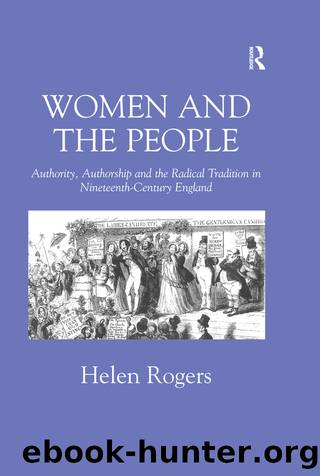Women and the People by Helen Rogers

Author:Helen Rogers [Rogers, Helen]
Language: eng
Format: epub
Tags: History, General
ISBN: 9781315318004
Google: lgckDwAAQBAJ
Publisher: Routledge
Published: 2017-05-15T04:55:20+00:00
III 'A tragic and touching romance': Henry Mayhew and the slopwomen
The Commissions of 1843 and 1864 were concerned with the application of factory legislation to dressmaking premises but did not investigate the working environment of domestic outworkers. By contrast, Henry Mayhew, the self-styled 'Metropolitan Commissioner' of the Morning Chronicle, went into the homes of slopworkers and discussed how women of all social classes could be forced into prostitution by sweated labour. A bohemian journalist, Mayhew was radicalised by his investigations of 'London Labour and the London Poor', serialised between October 1849 and December 1850 in the Morning Chronicle. Published soon after the 1848 Chartist demonstrations and the 1849 cholera epidemic, Mayhew's graphic reports of unemployment and poverty alerted the public to the plight of the London poor and placed the issue of sweated labour at the top of the reform agenda. In pioneering a sensationalist form of investigative journalism Mayhew interwove statistics and documentary observation with first-person testimonies, drawing heavily on established literary and dramatic conventions.38
By the mid-century the needlewoman had become a cultural icon although one which was profoundly unstable. As T.J. Edelstein suggests, representations of the solitary needlewoman could imply feminine saintliness and martyrdom, and a critique of the corrupt city, masculine vice, the avaricious employer and the indifference and vanity of wealthy women.39 The power of such representations rested, however, on the seamstress's temptation and resistance to the wages of prostitution and consequently the figures of the needlewoman and the prostitute were bound together in the 'Victorian imagination'. The propaganda produced by reformers was marked by the exchange between literary, artistic and social scientific representations of the needlewomen. Grainger's Report provided source material for Charlotte Tonna's The Wrongs of Woman (1844), while articles in The Times on the prosecution of a needlewoman for pawning work materials inspired Thomas Hood's poem 'Song of the Shirt' (1843) which itself became an anthem for reformers. Charles Kingsley's Alton Locke (1850) was probably the most famous literary response to Mayhew's survey and aimed to encourage Christian Socialist solutions to the proletarianisation of the London tailoring trades. Mayhew also framed the needlewomen's experiences within the conventions of melodrama, gothicism and romance as a 'tale', or a 'story', or 'a tragic and touching romance' as he introduced one 'poor Magdalen'.40 Mayhew and other investigators and reformers drew from these 'romances' a cautionary tale that presented the narrative resolution as moral rescue. They failed to detect in the needlewomen's evidence any political analysis and so were unable to imagine any independent action by needlewomen to redress their situation.
Mayhew's survey of 'London Labour' tested Malthusian and Utilitarian definitions of pauperism by examining the structural as well as the behavioural causes of poverty. He identified those who 'can't' as well as those that 'will' and 'won't' work and was sympathetic to women whom, he believed, had been forced into prostitution by poverty.41 While increasingly impressed by schemes enabling working men to help themselves, Mayhew saw needlewomen as helpless victims.42 He sought the political views of male
Download
This site does not store any files on its server. We only index and link to content provided by other sites. Please contact the content providers to delete copyright contents if any and email us, we'll remove relevant links or contents immediately.
On the Front Line with the Women Who Fight Back by Stacey Dooley(4800)
The Rules Do Not Apply by Ariel Levy(4795)
The Lonely City by Olivia Laing(4713)
Bluets by Maggie Nelson(4437)
The Confidence Code by Katty Kay(4166)
Three Women by Lisa Taddeo(3327)
Not a Diet Book by James Smith(3302)
Inferior by Angela Saini(3213)
Confessions of a Video Vixen by Karrine Steffans(3212)
A Woman Makes a Plan by Maye Musk(3178)
Pledged by Alexandra Robbins(3106)
Wild Words from Wild Women by Stephens Autumn(3047)
Nice Girls Don't Get the Corner Office by Lois P. Frankel(2975)
Brave by Rose McGowan(2765)
Women & Power by Mary Beard(2692)
Why I Am Not a Feminist by Jessa Crispin(2670)
The Girl in the Spider's Web: A Lisbeth Salander novel, continuing Stieg Larsson's Millennium Series by Lagercrantz David(2648)
The Clitoral Truth: The Secret World at Your Fingertips by Rebecca Chalker(2635)
Women on Top by Nancy Friday(2494)
